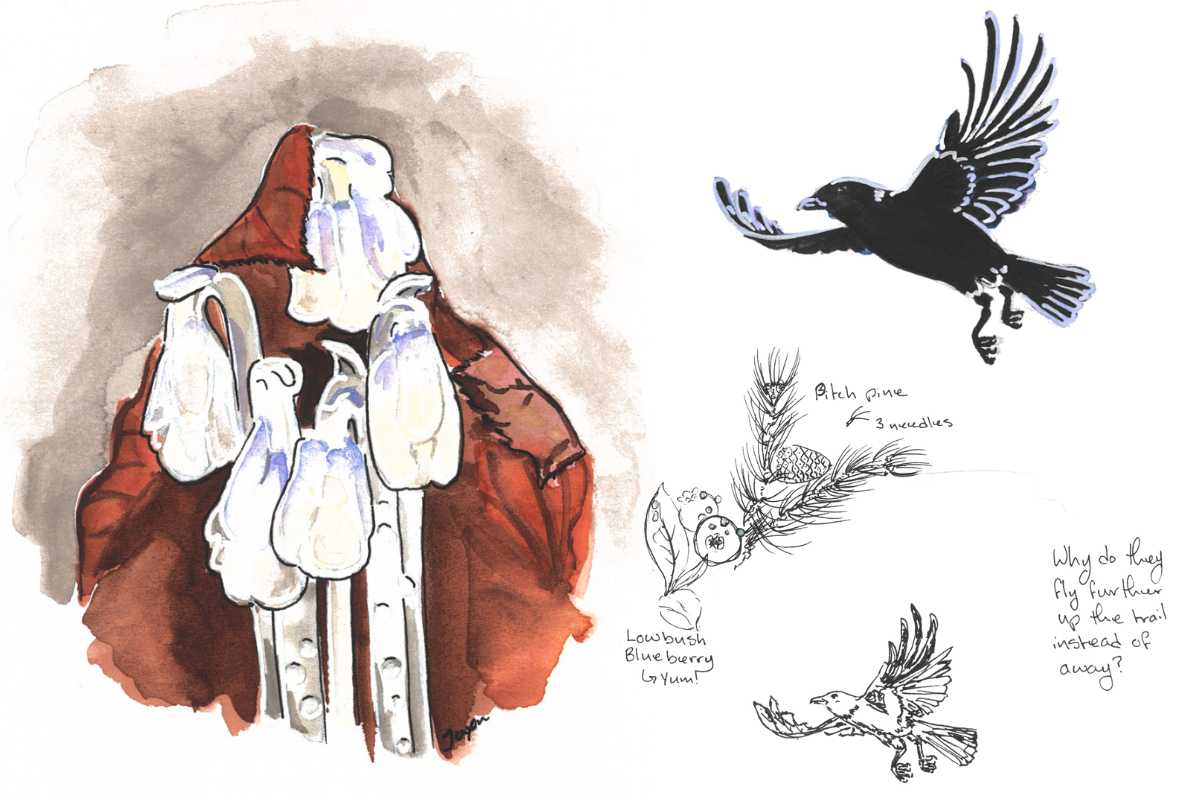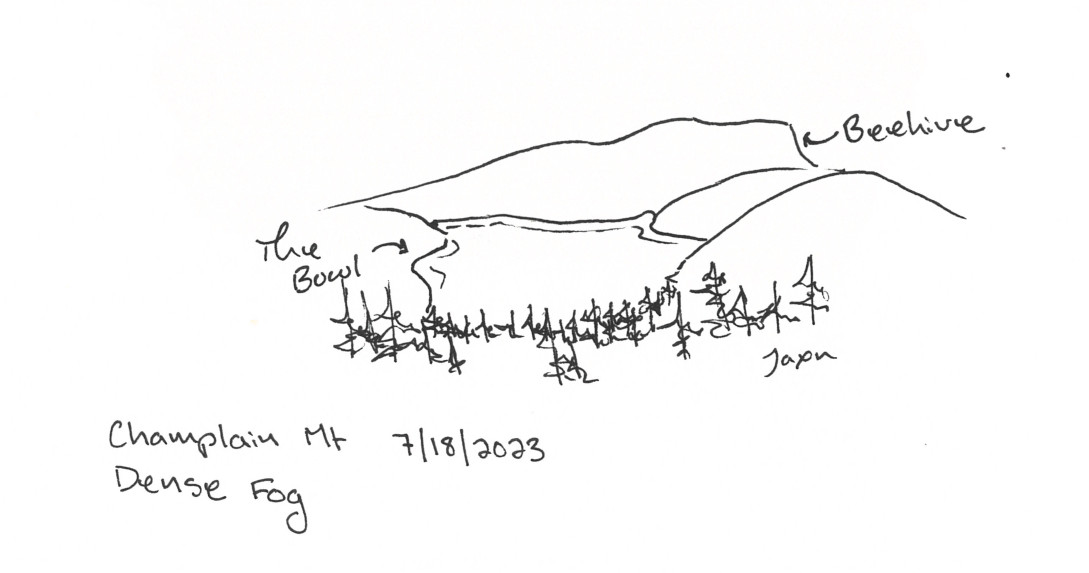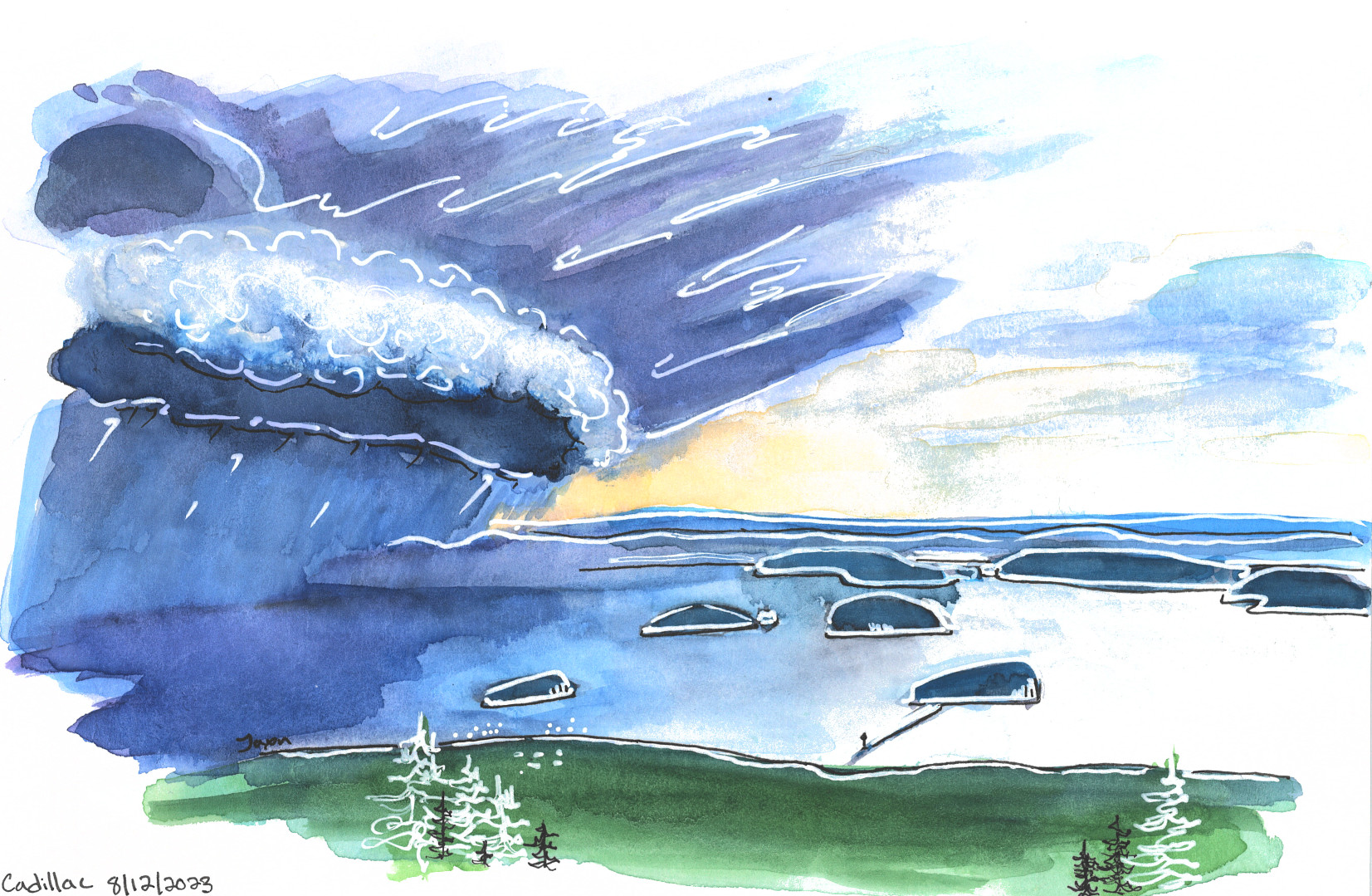Observations of Acadia from Summit Steward Ellie Jackson
October 27th, 2023
October 27th, 2023
EDITOR’S NOTE: There was rain and fog – lots of fog, in fact – and mornings that started before sunrise this season. But Friends of Acadia Summit Steward Ellie Jackson soaked in the park with every sense. Here she shares her observations of nature in inclement weather, which many park visitors never see.

Artwork by Ellie Jackson
BY ELLIE JACKSON
Occasionally I find myself thinking that Acadia has been domesticated by years of careful management. But the land always finds ways to reassure me that it is as wild as ever.
On the first sunny day after a week of rain, I chase waterfalls down the side of Cadillac Mountain. At the Featherbed, a small pond on the South Ridge, I turn east down Cannon Brook Trail. After easy walking on quick-drying pink granite, the brook quickly reminds me that it is in control. Water rushes over the trail, pouring down each stone step and across smooth slabs of rock.
The forest around me is wet and alive. Red wax-capped mushrooms pop through the browns and grays of decaying leaf litter. Ghost pipe (Monotropa uniflora), bedazzled with dew drops and cloaked in last fall’s leaves, droops white and shining under the dark canopy. Slowly, a snail creeps up the exposed root of a striped maple.
Water invites life out to play. And it makes each of my footsteps treacherous. The spring floods washed away many of the blue trail blazes, so I am navigating across slippery stones with intuition and common sense. Visitors with wet boots warn me not to take this trail. But my feet are already squelching gloriously in my socks. This trail is dangerous and amazing when it rains; I have to test my feet to watch the rain carry the mountain to the sea.

Artwork by Ellie Jackson
When I was little, I dreamt of bouncing and playing on puffy silver clouds. Today on Champlain Mountain, I abandoned that dream and walked into a real cloud. Here, the world is awash in mist and blueberries.
From a nearby stand of pitch pine, crows eye my progress. Every few minutes I get too close, and the crows erupt in croaking and leap to a new tree just up the trail from me. Their pitch-black feathers punch a hole in the monochrome gray sky. They too are enjoying the mist, catching it on their feathers and arcing through the air on their trips from refuge to refuge. They dart into a stand of sheltered pines only feet from me. One crow stares at me, jitterbugging at each of my careful steps. I stoop to pick a blueberry, and my nervous avian companion is gone, leaving me to my trail maintenance.
Sunny days provide good visitor interactions and even better views, but wind and fog are comforting.
The wind blows sweat from the back of my shirt. The cloud invites me in by collecting sparkling droplets on the curling hairs around my face. When I hike in a blustering cloud, I can only see the steps immediately in front of me, which makes the trail seem to stretch endlessly. In this sublime space, I focus on each step toward the next blue trail blaze or silhouette of a Bates cairn.

Artwork by Ellie Jackson
Although I spend my weekdays asking visitors to protect plants and wildlife by staying on trails, I spend my weekends going off trail to protect plants and wildlife. This weekend in late July is no exception.
Yesterday evening, a team including myself, led by Dr. Brittany Slabach, opened little boxes (Sherman live traps) on the summit of Sargent and tossed small mammal bait made of peanut butter, bird seed, and mealworms inside. We set traps in the evening to minimize the time any creature might be in one.
An orange sunset rewards our patience.
The next morning, I crawl out of bed at 2:00 a.m. to summit by 4:45 a.m., reaching the top just before the pink sunrise. Happily munching, the mammals await our arrival. We gingerly carry traps with captures across the summit to Dr. Slabach. She pulls a female wild mouse, snacks in hand, out of one box. The mouse is pregnant and annoyed by our disturbance, so we quickly measure and tag her before returning her to where she was caught. As she scampers beneath a wood lily, we scamper on to the next trap.
Mice and voles are vital summit community members. The Wild Acadia Summit Restoration Project will fill trampled social trails with soil to encourage growth of native plants. This restoration should help plant communities to be more resistant to erosion caused by careless explorers and intense rain, but we want to know how it will affect the whole summit community. As this project progresses, we will continue to study small mammals to understand all our impacts on the summit.

Artwork by Ellie Jackson
Standing on the sun-soaked summit of Cadillac Mountain, I notice a shadow crossing the corner of my view. Gray rain squalls dance over the Schoodic Peninsula. I look away to speak with a visitor; turning back, a marching storm front has replaced the dancing squalls. Soft blue-and-purple clouds lead a charge across the sky, towing a line of churned rainclouds, followed by a dense curtain of rain.

Summit Steward Ellie Jackson. (Photo courtesy Ellie Jackson)
From the shelter of my car, I watch lightning streak and flash across the distant wall of rain. Dark clouds consume the sky. Each time the horizon turns pure white, I am struck with awe and gratitude.
When the first drops of rain finally hit my roof, I roll up my windows and watch the downpour chase visitors back to their vehicles.
As the rain eases, the mist on the edge of the storm collides with the light, stringing a rainbow between the mountain and the clouds. The horizon fills back up with white clouds as the parking lot on the summit fills back up with cars.
Visitors to Acadia purchase a Cadillac Summit Road vehicle reservation to see the amazing views from the summit, but the beauty of the mountain is not just in the birds-eye-view of Bar Harbor or the offshore islands to the west. Most visitors leave for fog or storms, but for me, the mountain comes alive in inclement weather.
FOR YOUR SAFETY: Acadia’s trails, particularly its eastern and western mountain approaches, often have water running down the trail tread after rain.
The granite slabs become slick and can catch even the most seasoned hiker off guard. Incidents along these trails can be serious and require technical search and rescue due to the trail conditions. Please exercise caution when hiking Acadia’s mountains after the rain by wearing footwear with good traction and maintaining well-balanced footing.
ELLIE JACKSON is a member of Friends of Acadia’s Summit Stewards seasonal team. She is a third-year student at College of the Atlantic, focusing on writing and science communication.